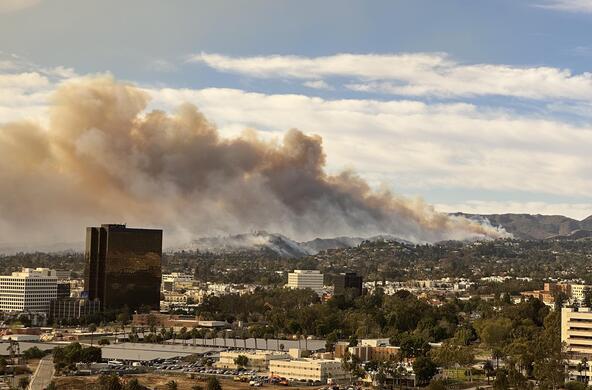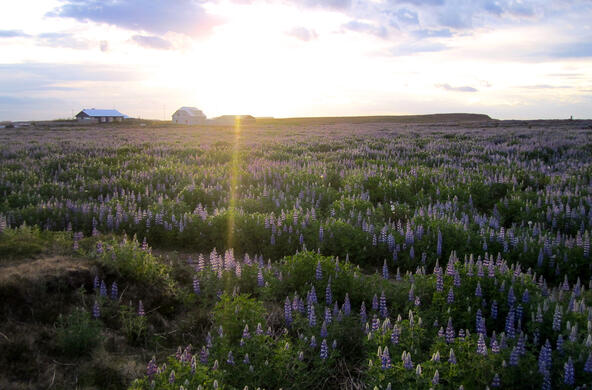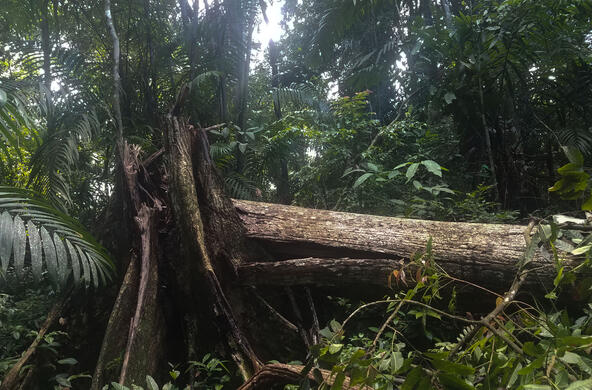In building climate models, one of the most difficult jobs is to incorporate the effect of clouds and particles, known as aerosols, in the atmosphere. Do they warm or cool the planet?
The answer depends on many attributes of cloud droplets and particles—their size, color and altitude, and the time of day and reflectivity of the underlying surface. There seems little doubt that large volcanic eruptions put lots of particles in the upper atmosphere, producing periods of global cooling for several years.[1] Do the small water droplets in clouds act the same way?
Next time you are flying in an airplane along the coast, check out the color of a smoke plume blowing out over the ocean. Typically, the plume will appear whitish, indicating that it is reflecting more radiation to space than what is being reflected the surface of the water beneath. That cloud is cooling our atmosphere. If it wasn’t there, the ocean would absorb more incoming radiation from the Sun.
Then, take a look at a plume of smoke over desert or otherwise barren soil. Typically the plume will look dark, meaning that it is absorbing radiation given off by the surface below. That cloud is warming the atmosphere.
This will vary somewhat depending on whether the plume you are studying is mostly composed of water vapor or whether it contains a significant fraction of blackened or soot particles, as from a forest fire. These observations are also affected by the color of the surface below. Bare soils and snow reflect more than forests.
Airplane contrails are largely composed of water vapor that condenses into small droplets in a cold atmosphere. These particles will cool the atmosphere during the day and warm it at night. The cooling during the day matches what we said about a cloud over the ocean. The warming at night occurs because the incoming radiation is relatively diminished (after all, it is dark outside), yet the Earth’s surface is still reradiating to space. Some of this radiation is absorbed by the contrail, warming the atmosphere.
The only good thing that stemmed from the 9/11 terrorist attacks on America was an inadvertent experimental test of these observations during the 3-day period when all aircraft were banned from the skies. On those days, the temperature range was significantly greater than normal—the highs were higher and the lows were lower. Thus, normally contrails would seem to cool us during the day and warm us at night.
As the world warms, the atmosphere will be able to hold more water vapor, so cloudiness will increase. The small droplets in these clouds are likely to act like airplane contrails to cool the planet during the day and to warm it at night. The latest report of the Intergovernmetal Panel on Climate Change (IPCC) indicates that taken alone the overall effect of clouds will be to cool the planet. Unfortunately, this cooling effect (-0.35 W/m2) is dwarfed by the warming from CO2 (+1.82), methane (+0.48) and nitrous oxide (+0.17) that humans have added to the atmosphere.
Airplane contrails have little impact on climate,[2] but, contrails are an interesting surrogate for what clouds may do in the future. [3]
References
Burkhardt, U. and B. Karcher. 2011. Global radiative forcing from contrail cirrus. Nature Climate Change 1: 54-58.
Chen, C-C. and A. Gettelman. 2013. Simulated radiative forcing from contrails and contrail cirrus. Atmospheric Chemistry and Physics 13: 12525-12536.
Gettelman, A. and C. Chen. 2013. The climate impact of aviation aerosols. Geophysical Research Letters 44: 2785-2789
Kellogg, W.W. 1992. Aerosols and global warming. Science 256: 598
Sigl, M., M. Winstrup, J.R. McConnell et al. 2015. Timing and climate forcing of volcanic eruptions for the past 2,500 years. Nature 523: 543-549.
Spangenberg, D.A., P. Minnis, S.T. Bedka, R. Palikonda, D.P. Duda and F.G. Rose. 2013. Contrail radiative forcing over the Northern Hemisphere from 2006 Aqua MODIS data. Geophysical Research letters 40: 595-600.
Travis, D.J., A.M. Carleton, and R.G. Lauritsen. 2002. Contrails reduce daily temperature range. Nature 418: 601.
[1] This effect of volcanoes is much more significant than their release of CO2. See my blog of March 14, 2015: Volcanic carbon dioxide.
[2] About 0.013 W/m2
[3] Conspiracy theorists have suggested that governments are using aircraft to put chemicals into the atmosphere, forming “chemtrails,” perhaps to cool the Earth. There is no factual evidence that this is happening, and no good evidence that it would be very effective. Proposals to put reflective aerosols into the stratosphere are more interesting, but with a potential host of environmental problems that I will cover in another blog.







